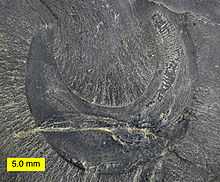Ottoia
| Ottoia Temporal range: Middle Cambrian | |
|---|---|
 | |
| Reconstruction of Ottoia in a burrow. | |
| | |
| The anterior portion of Ottoia, illustrating annulation and the eversible proboscis. | |
| Scientific classification | |
| Kingdom: | Animalia |
| Stem-group: | Priapulida |
| Class: | †Archaeopriapulida |
| Family: | †Ottoiidae Walott, 1911 |
| Genus: | †Ottoia Walcott, 1911 |
| Species | |
| |
Ottoia is the most abundant priapulid of the Cambrian Burgess Shale formation of British Columbia and Wheeler Shale formation of Utah dating from the Mid-Cambrian of around 505-510 million years ago. It is a stem-group priapulid worm.[1]
Morphology
Ottoia specimens are on average 8 centimeters in length. Both length and width show variation with contraction; shorter specimens often being wider than longer ones. The characteristic proboscis of priapulids is present at the anterior, attached to the trunk of the animal, proceeded by the "bursa" at the posterior. The organism's body is bilaterally symmetrical, however, its anterior displays external radial symmetry. Like some other modern invertebrates, a cuticle restricts the size of and protects the animal. The everted proboscis of Ottoia is armed from the distal end by spinules, spines, and hooks. The spinules appear in varying shape and size, classifiable into four types which are comparable to the teeth of modern priapulids. Posterior to the spinules, separated by an unarmed region, are about 40–50 spines. Further posterior are hooks, relatively well spaced from each other and arranged like the five dots on a domino or die. The proboscis most likely would not have been fully everted (turned inside out) when feeding.
The trunk hosts the internal organs of the organism, divided into seventy to a hundred annulations of varying spacing, depending on curvature and contraction. The posterior displays a series of hooks, which likely acted as anchors in burrowing. Muscles support the animal and retract the bursa and proboscis. A gut leading from the anus in the bursa to the mouth in the proboscis runs through the trunk's spacious body cavity, and a concentration of gut muscles serve the function of a gizzard. A nerve chord runs down the organism's length. In addition to the other organs, it is possible Ottoia contained urogenital organs in its trunk. There is no evidence of a respiratory organ, though the bursa may have served this purpose.[2]
Ecology
Ottoia was a burrower that hunted prey with its eversible proboscis.[3] It also appears to have scavenged on dead organisms such as the arthropod Sidneyia.[4]
The spines on the proboscis of Ottoia have been interpreted as teeth used to capture prey. Its mode of life is uncertain, but it is thought to have been an active burrower, moving through the sediment after prey, and is believed to have lived within a U-shaped burrow that it constructed in the substrate. From that place of relative safety, it could extend its proboscis in search of prey. Gut contents show that this worm was a predator, often feasting on the hyolithid Haplophrentis (a shelled animal similar to mollusks), generally swallowed them head-first. They also show evidence of cannibalism, which is common in priapulids today.
Preservation
Because of its bottom-living habit and the location of the Burgess Shale site at the foot of a high limestone reef, one may presume the relative immobility of Ottoia placed it in danger of being carried away and/or buried by any underwater mud avalanche from the cliff top. This may explain why it remains one of the more abundant specimens of the Burgess Shale fauna.
Distribution
At least 1000 Burgess Shale specimens are known in the UNSM collections alone,[2] in addition to the ROM collections and hundreds of specimens elsewhere. 677 specimens of Ottoia are known from the Greater Phyllopod bed, where they comprise 1.29% of the community.[5]
Ottoia is also known from Middle Cambrian deposits in Utah and Spain,[6] and Nevada.[7]

References
- ↑ Budd, G. E.; Jensen, S. (2000). "A critical reappraisal of the fossil record of the bilaterian phyla". Biological Reviews of the Cambridge Philosophical Society 75 (2): 253–95. doi:10.1111/j.1469-185X.1999.tb00046.x. PMID 10881389.
- ↑ 2.0 2.1 Conway Morris, S (1977). "Fossil priapulid worms". Special papers in Palaeontology 20.
- ↑ Vannier, Jean (August 2009). "The Gut Contents of Ottoia (Priapulida) from the Burgess Shale: Implications for the Reconstruction of Cambrian Food Chains" (PDF). In Smith, Martin R.; O'Brien, Lorna J.; Caron, Jean-Bernard. Abstract Volume. International Conference on the Cambrian Explosion (Walcott 2009). Toronto, Ontario, Canada: The Burgess Shale Consortium (published 31 July 2009). ISBN 978-0-9812885-1-2.
- ↑ Bruton, D. L. (2001). "A death assemblage of priapulid worms from the Middle Cambrian Burgess Shale". Lethaia 34 (2): 163. doi:10.1080/00241160152418456.
- ↑ Caron, Jean-Bernard; Jackson, Donald A. (October 2006). "Taphonomy of the Greater Phyllopod Bed community, Burgess Shale". PALAIOS 21 (5): 451–65. doi:10.2110/palo.2003.P05-070R. JSTOR 20173022.
- ↑ Conway Morris, S.; Robison, R. A. (1986). "Middle Cambrian priapulids and other soft-bodied fossils from Utah and Spain" (PDF). University of Kansas Paleontological Contributions 117: 1–22. hdl:1808/3696.
- ↑ Lieberman, B. S. (2003). "A New Soft-Bodied Fauna: the Pioche Formation of Nevada". Journal of Paleontology 77 (4): 674–690. doi:10.1666/0022-3360(2003)077<0674:ANSFTP>2.0.CO;2. ISSN 0022-3360.
External links
- "Ottoia prolifica". Burgess Shale Fossil Gallery. Virtual Museum of Canada. 2011.
- Ottoia prolifica (A priapulid worm) from the Smithsonian Institution.
- Ottoia prolifica from the Hooper Virtual Paleontological Museum (HVPM)